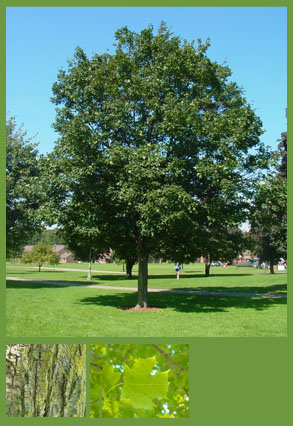Class: Rosidae
Origin: Sapindales
Family: Aceraceae
As with other members of the maple genus, sugar maples contain simple leaves in an opposite configuration along its branches. The leaves of Acer saccarum contain five lobes and are usually greater than 4 inches long. The sugar maple can be distinguished from other members of the Acer family because of a few unique leaf characteristics. The sinus, the space between two lobes, on the sugar maple is “U” shaped compared to many of the Acer families “V’ shaped counterparts. The leaf is broad and sharply toothed. The terminal buds of the sugar maple are very sharp and pointy. From a distance, the sugar maple has a beautiful elliptical and symmetric crown. Many trees can grow to over 100 feet tall. The samaras are the trees seeds which are horseshoe shaped- double lobed and symmetrical. The samaras hang from a long stem until the are released at maturation, usually in the Fall. Buds on the sugar maple are slender and rather pointy, they are hard to distinguish from the end of the branch. Sugar maples can be found throughout all of New England and surround the Southern areas of the Great Lakes, moving as far South as Tennessee.
Branching information:
While students importantly jaunt from their homes on campus to cram their notes in Durrik library, Acer saccarum continuously does its work. Life isn’t all glamour and fun when you are Vermont’s state tree. Expectations are high and making sugars is tough work that is seemingly only appreciated on top of a pile of steaming pancakes. Vermont gives its sugar maple trees no rest because Vermont is the highest US producer of maple products.
Sugar maples are of course known for their product of maple syrup. No one really seems to know exactly when people began to realize how to extract and create maple syrup, but there is historical evidence to suggest that many Native Americans were bartering with maple syrup in the 1600s.
Back |
 |